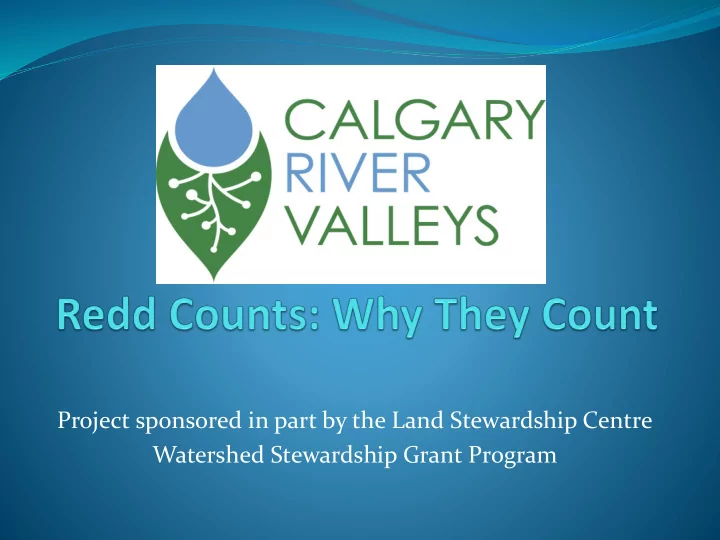

Project sponsored in part by the Land Stewardship Centre Watershed Stewardship Grant Program
What is a redd? A redd is a fish spawning nest, indicated by an area of clean, whiter-looking gravel
** add video of Chris B (approx 5 mins re Redd Count)
History of Lower Elbow Brown Trout Redd Count Counts of Brown Trout Redds on the Lower Elbow began in Calgary in 1980 Counts were not done every year until 2008 Calgary River Valleys has been coordinating and sponsoring the count every year since 2009
Why Brown Trout Redds While Brown Trout aren’t a native species in Alberta, having been introduced from Europe, they are now common in rivers & streams in Alberta’s foothills Brown Trout have adapted well to the ecosystem here in Calgary, and are out-competing the native species in some areas The counts are done after spawning is complete Brown Trout spawn in the fall, unlike Rainbow Trout that spawn in the spring, so the river is easier to walk in during the fall as it isn’t likely to be as high as in the spring
Why Brown Trout? There are 63 species of fish in Alberta, but only 17 are considered “game fish” and are preferred by anglers. Of these 17, the Bow & Elbow Rivers within, as well as upstream & downstream of, Calgary have at least 9 of these “game fish”, which are: 1. Brook Trout 6. Burbot (Freshwater 2. Brown Trout cod) 3. Lake Trout 7. Mountain Whitefish 4. Cutthroat Trout 8. Northern Pike 5. Rainbow Trout 9. Walleye Source: www.AlbertaFishingGuide.com
** angling industry value to economy The sport fishing industry is a multi- million dollar industry in Calgary Counting the redds and comparing the data from year-to-year can indicate the health of the aquatic ecosystem
Why is the annual count important? In addition to monitoring the aquatic health of the lower Elbow River, as indicated by spawning activity; To collect consistent data over time and analyze trends relative to development, severe events, climate change, etc; To encourage high school or university students to pursue the field of aquatic biology (educationally and/or professionally); and To educate adjacent landowners, recreational river-users and government personnel involved in river management decisions; and To provide some direction for land use & river development decisions.
**here? Count Chart to 2016??
** Redd Location comparison year- to-year ?? **
** Redd Location comparison year- to-year ?? **
Redd Locations year-to-year **
Conclusions re data ** Shifting of small gravels further downstream ** Flood impacts,
Questions to be answered ** ** whirling disease ** water flow
Why Brown Trout Redds? Fall spawning trout – how to know which redds are for Browns — do we care?** Brown Trout: Golden brown or olive Lake Trout: Grey with irregular white back & sides. Dark spots on sides & spots. During spawning season, the back. Red spots with bluish halos. fins near the tail become a pale orange. Brook Trout: Dark green back with pale wavy lines. Sides have a purple sheen with blue-haloed red spots. Lower fins have a black stripe behind a pale leading edge.
Recommend
More recommend